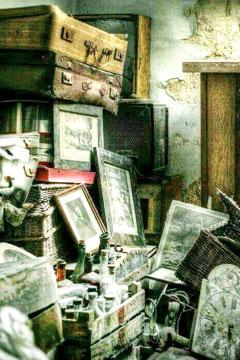
The attic is a place or room just below the roof of a house, often used for dumping unwanted household items. In modern houses you hardly find an attic, but there is always a backroom allocated for storing things not necessary for daily life. Even this is not possible in modern apartments where people live vertically. In the olden days rich people built spacious houses with attics. Those who lived in such houses never threw away any empty bottles, broken pieces of furniture, old clocks and crockery. All of them found a place in the attic.
A friend of mine used to live in an old walauwa in the South of the country. He was living with his doddering parents. Whenever I visited him, we used to rummage around the attic. It was a fascinating exercise. We found many rare items such as old stamps bearing the picture of Queen Victoria, crockery carrying the prestigious mark ‘VOC’, the original editions of Sandesha Kavyas, a copy of Sidathsangarava, and slightly damaged or defaced statutes of the Buddha and many gods.
While talking to my friend’s father, I learnt that he had been a great stamp collector in his young days. Today, very few people are interested in collecting old stamps. They are always playing with electronic gadgets. Another reason is that we get only a very few letters by post. We are hooked to the e-mail which is faster and cheaper than snail mail. One day, he told me a story about a Postmaster who designed a postage stamp and got it printed for sale at the post office. In modern times, however, there is a Philatelic Bureau which handles designing, printing and distributing stamps to post offices. According to the narrator, the postmaster lived in British Guiana in the latter part of the 19th century.
Postmaster
One day, the postmaster found that he was running short of postage stamps of a particular denomination. Those days stamps were printed in England and sent to post offices in the British colonies. As a result, there were long delays in getting the stamps. To meet the demand, the postmaster had a brainwave. He called the local printer and discussed the problem he was faced with.
The printer said he did not know how to design stamps, but he could print them. Being an enterprising man, the Postmaster selected the picture of a ship published in a local newspaper and asked the printer to go ahead with the printing. The Postmaster then realized that someone else could counterfeit the stamps. So he and another postal clerk initialled the stamp design before printing. The printed stamps were of one-cent denomination. A large number of people bought them and posted their letters.
At last, a stock of stamps arrived from England and the postmaster decided to destroy the stock of stamps printed by him. Everybody forgot about the one-cent stamp printed by a local printer. However, after about 60 years a used one-cent stamp was sold at an auction for $30,000. The stamp had been discovered by a boy who rummaged around the family attic. At first, he did not realize its market value. So, he removed the old stamp from an envelope and put it in his album. One day, he wanted to sell some of his old stamps and replace them with new ones. He removed the one-cent stamp thinking it was worthless. He took it to a stamp seller but the latter was not interested in buying it. After some time, he agreed to buy it for six shillings. Later the collector sold the entire collection including the one-cent stamp to Count Phillip la Renotier von Ferrary for 125 pounds. After the Count’s death, the entire collection of stamps was seized by the French government. Later the stamps were sold at an auction. The one-cent stamp was bought by a certain person for 7,000 pounds.
Today, there are professional designers of postage and revenue stamps. Only a few artists take to stamp designing as it is a demanding job. I remember a highly talented young stamp designer who worked at Upali Newspapers and Lake House for a brief period. He went to Germany on a scholarship and returned to Sri Lanka as a highly qualified stamp designer. However, his brilliant career was cut short by a bomb exploded by the Liberation Tigers of Tamil Eelam.
Stamp collector
I have heard another interesting story about a stamp collector. He was a young man who lived in the early 1860s. He was serious about collecting stamps and devised a novel method to acquire foreign stamps. He sent a five-pound note to the postmasters of each British colony. Later he joined the British army and served in different countries. In the meantime, the postmasters sent him sheets of postage stamps. His parents preserved them in a trunk waiting for his return. However, he was killed in battle and everybody at home forgot about the trunk containing stamps. Some years later a man who was rummaging around the attic came across the large collection of stamps. For him, it was a veritable gold mine. He collected more than $50,000 from the sale of these stamps.
While I was employed in a media organization, a clerk from another department used to search every nook and corner of the building to collect used stamps. While collecting stamps he used to narrate various anecdotes. His eyes gleamed when he saw foreign stamps. I am sure he is still rummaging around the attics of his ancestors.
What has to be remembered is that there may be something interesting and valuable in your attic or the attic of another person. If you happen to rummage round an attic, you may find a pot of gold!
